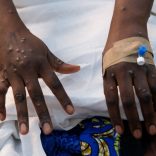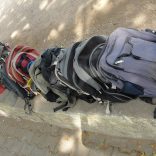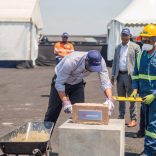UN refugee agency plans to reduce spending by a fifth, close Southern Africa office as cuts bite
Mozambique: A paracetamol for cancer

A woman climbs the 16 steps up to the Oncology Department like a climber ascending Everest. Her movement is slow and unsure, her legs are heavy. The heat saps her strength: she is sick. Melita Boca, 43, arrives on the balcony exhausted and, without saying a word, flops into one of the chairs scattered there. Acacias and well-tended flowerbeds surround the colonial-style building, strangely tranquil considering that those who arrive there come to die.
Now seated, Melita undoes the top button of her denim skirt and rubs her stomach, revealing a scar running from one side to the other. She wriggles in the armchair, looking for a less painful position.
To get to Maputo Central Hospital, Melita left her six children, one newborn, in the care of her younger sister and rode two minibuses clutching the doctor’s prescription she hopes will buy her some relief from the pain that has wracked her body for four full days.
Still breathless, she says softly, almost apologetically, that she “can’t stand” it, that she needs “medicine”.
A little over a month ago, soon after the birth of her last child, her left kidney was removed, and the biopsy results procured her an appointment a few days later. There, she was given an injection for pain and a prescription for paracetamol that was fulfilled in the hospital pharmacy.
Almost all patients that end up in the Oncology Department are going to die. “They are terminally ill, we only have palliative chemotherapy,” says 36-year-old head nurse, Juvenal Santos Dinis. “It is very rare that we think about healing,” he sighs. “It’s only five or six years that we’ve been talking about cancer. Before that, people used to die at home, without even knowing why.”
Dinis the soul of the unit, his name on everybody’s lips. Dinis prepares chemotherapy doses and blood transfusions and guides the team. He moves between the small cubicles where they keep the drugs, the nursing consultation room and the chemotherapy room, where, in little over twenty square metres, 18 patients a day sit in the well-worn napa sofas.
On television, the typical morning programs broadcast their forced cheerfulness. The metal cabinets that fill one wall are full of wool blankets. The middle of the room is filled by chemotherapy and serum bags hanging from a stand with five hooks, like an open hand.
There is not much space to move around, but no one trips, no one is in a hurry. The equipment is a bit rusty and shared by five patients. In a room without air conditioning, with 90 percent humidity and temperatures often over thirty degrees, even breathing is difficult. But you do not hear a whimper of complaint.
ONE ONCOLOGIST FOR A NATION
In a year and a half, the department, which is the principal oncology unit in the country, has dealt with 1,500 cancer cases – very few, considering the country’s 20 million inhabitants. Of these, 80 percent arrived at an advanced stage of the disease, and received only palliative care, director of the oncology service Satish Tulcides says. “But it’s not all bad news. Even with limited resources, I’ve had patients for five or six years,” he says proudly.
In 2015, Juvenal spent two months in Porto, training at São João Hospital. With its long-standing relationship with the hospital, the Gulbenkian Foundation had set up an oncology care training program and recruited partners – the Camões Institute, the Millennium-BCP Foundation and the Mozambican Bank BIM – to work on various areas in the treatment of cancer. It was not the most obvious choice, but major donors like the Bill and Melinda Gates Foundation have focused on tuberculosis, malaria and AIDS.
In total, half a million euros were allocated to improve training and provide equipment. “In oncology, we still lack a lot,” admits hospital director, João Fumane, who is well aware that for a year and a half he was the only oncologist in the country. “That is why I seized this opportunity with velvet gloves. At one point, I had to do everything myself. Attend adults, children, guide treatments and palliative care,” he remembers.
The results will not be visible immediately, admits the director of the Calouste Gulbenkian Foundation’s Partnership for the Development, Maria Herminia Cabral. “The main investment is in the training of human resources,” she notes. “It is institutional support, not a replacement project. All decisions are made in consultation with HCM’s directors, who have managed to find in their own budget the funds to build the day hospital, improve the pharmacy and relaunch the radiotherapy service. All of these improvements have been achieved with tools chosen and supported by the project.”
From Portugal, where he says he felt welcome from day one, Juvenal brought back several ideas, starting with patient management and drugs regimes. “On the course, they taught us the ideal, but here we have to improvise. In the chemo room in Porto there were two nurses for each patient. Here there are two for 18.”
“It was hard to come back,” he admits. To survive the work, Juvenal took a course in psychology. “Sometimes I feel like giving up. But I cannot.”
The walls in the building need paint, and the yellowing sheets cry out for replacement. But it’s the smell that makes the greatest impression. Heavy, thick, rotten. “It’s the cancer wounds,” explains Mariana Brandão, a Portuguese doctor who came to work at the hospital as a volunteer for three months. “In Portugal, it is very rare to find a patient with an ulcerated cancer. In Mozambique it happens in 90 percent of breast cancer cases.” She cites the case of one woman, among many others, who had her first oncology consultation two years after having first felt the lump in her breast.
In one of the beds, a patient waits for her husband to bring her proof that he has given blood, so that she can get a transfusion. She is suffering from advanced breast cancer and has a haemoglobin count of six – half the minimum acceptable. The country has a blood bank but, in order to remain sustainable, it will only authorize transfusions after a blood donation from a family member of the patient. For those who are alone – which happens often – there is a group of volunteers to the hospital can appeal to.
Tulcides proudly displays the empty room in the basement of the building, which will soon open as new day hospital. Just four painted walls and a tile floor, but, when equipped, it will avoid Melita’s painful climb up those 16 steps. “In this hospital I am a doctor, a foreman – I do everything,” he says. It was he who initiated the rehabilitation of the once-abandoned space.
Right next to it will be the long-awaited radiotherapy department, the first in the entire country. How can you treat cancer without one of the main weapons used to fight it? Gudo Alberto Morais, 35, the only radio-oncologist in the country, does not despair. “We adapt what we have available. We do more radical surgery and have aggressive chemotherapy regimens. And we have been able to heal people,” said Morais, who graduated in São Paulo, Brazil. “You don’t always need a Ferrari. Often a small utility van will take you where you need to go,” he says.
When we cross the hospital to the Pathological Anatomy service, it feels like we’ve crossed an ocean. Everything is familiar, from microscopes to the board on the wall announcing “Sala Manuel Sobrinho Simoes”. The Pathological Anatomy service dates from the 1990s and a collaboration with the then director of the Molecular Pathology and Immunology Institute of the University of Porto. When he came on board, the main sponsor was Norway. “With increased longevity, cancer begins to be a serious problem. We have to attack it with well-made, reliable diagnosis. Only then can progress to treatment,” he says.
Carla Carrilho is the director of the service and a disciple of Sobrinho Simoes. Part of her task, also part of the program coordinated by the Gulbenkian Foundation, has been managing the hospital’s cancer records. “’Cancers of civilization’ are yet to appear. For now, we mainly have cervical cancer [associated with human papillomavirus, or HPV], in a very advanced state, plus liver and breast cancer, and even cancers associated with AIDS, such as lymphoma and Kaposi’s sarcoma.”
Preventable cancers, in other words. The vaccination of eight thousand children against HPV was a first step in reversing these deadly statistics. The programme is now expected to be extended to the whole country.
A HOSPITAL WITHOUT A WHIMPER
Where ever she goes, Doctor Emilia Miquindade takes her pain scale – a sheet of cardboard with ten faces representing suffering from zero to ten, a state of uncontrollable pain. “I often ask, ‘What is your level of pain?’ And they answer, ‘Normal, it is here for me,'” she says. “No! Pain is not normal,” she seems to want to scream. As a doctor at Maputo Central Hospital, this is her main task: to convince patients that suffering does not have to be part of life. After specializing in the area of pain and working in Spain, the 37-year-old returned to Mozambique to lead the unit. “It is a cultural issue. People here do not complain. In Valencia, they complained … ” she says, ruefully.
Yes, European patients complain; Mozambicans don’t utter so much as a whimper. One comes away from the hospital not believing the silence, the serenity with which people accept lack – lack of medicines, places to sit, water in the drinking machines. “When they arrive, most patients are between level 7 and 10. We only let them go when they are at zero,” Dr Miquindade says, boasting of having everything she needs to achieve results: a portable ultrasound machine, morphine in liquid and tablet form. “Life here is very hard, people are accustomed to suffering and have a higher pain threshold. We get good results with just paracetamol sometimes.”
That is the relief which is possible for Melita’s cancer.












Leave a Reply
Be the First to Comment!
You must be logged in to post a comment.
You must be logged in to post a comment.